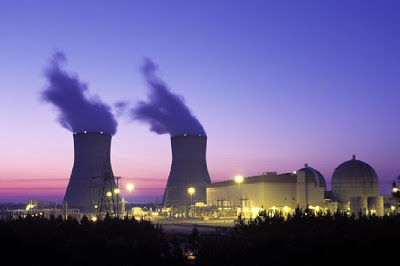Lab report:
Is the ‘nuclear renaissance’ dead yet?
By Harvey Wasserman / The Rag Blog / September 13, 2010
America’s much hyped “reactor renaissance” is facing a quadruple bypass. In actual new construction, proposed projects, and overseas sales, soaring costs are killing new nukes. And the old ones are leaking like Dark Age relics teetering on the brink of disaster.
As renewables plummet in cost, and private financing stays nil, the nuclear industry is desperate to gouge billions from Congress for loan guarantees to build new reactors. Thus far, citizen activism has stopped them. But the industry is pouring all it has into this fall’s short session, yet again demanding massive new subsides to stay on life support.
Here’s a lab report:
- Soaring costs at Vogtle, the U.S.’s one active new reactor project, have stuck Georgia ratepayers with $108 million in unplanned overcharges… and that’s just for starters at a site where actual construction has barely begun. Georgia’s PUC now says it will hike rates by nearly 3 times the original $1.30/month promised when it first agreed to soak ratepayers for the plant — in advance. This new hike was opposed by the PUC’s own staff, which blasted the whole deal for being shrouded in secrecy.
Currently calculated to cost a sure-to-soar $14.5 billion, the Vogtle project got $8.33 billion in federal loan guarantees from Obama in February. Citizen/taxpayer groups have since sued to see the details, which the administration is keeping secret.
Such soaring rates and slipping schedules defined the first generation of “too cheap to meter” reactors, which almost without exception came in years late and billions over budget. Costs of the two original Vogtle reactors jumped by 1,263% — from an original $660 million budget to nearly $9 billion — forcing up statewide rates more than 12%. Construction was promised for seven years, but actually took 16.
The French giant AREVA’s “new generation” projects in Finland and Flamanville, France, have also soared hugely over budget and behind schedule. So there’s every indication the new generation of reactors will be as catastrophically behind schedule and over budget as the first.
- John Rowe, the CEO of Exelon, America’s top reactor owner (17 in 3 states), says low gas prices could delay construction of new merchant nukes in the U.S. by a “decade, maybe two.” Merchant power plants sell electricity into open competitive markets. Because atomic energy can’t compete with natural gas or renewables and efficiency, Exelon has withdrawn its application to build two reactors in Victoria County, Texas. “We haven’t totally abandoned” the project, says Rowe. But “it’s very unlikely we would do it for a long time.”
- American reactor component makers are angry with India for passing new law requiring the industry to assume substantial liability for a catastrophe they might cause. The horrifying aftermath of Bhopal, where Union Carbide killed thousands of local citizens with a lethal gas emission for which they have not been held fully accountable, still weighs heavily in India.
But the atomic industry will not tread where it’s held liable for the true costs of its potential disasters. In the U.S., liability is capped at around $11 billion, even though the financial damage from a full-scale catastrophe could easily soar into the trillions. Minimum estimates from the 1986 Chernobyl disaster, which occurred in a remote, impoverished area, have exceeded $500 billion. By recent estimates the death toll is 985,000 and still counting.
On behalf of U.S. corporations, the Obama Administration is demanding the Indian liability requirements be lifted. Especially in the wake of BP’s Deepwater Horizon catastrophe in the Gulf of Mexico, it is a stunning admission that even after 50 years, reactor technology cannot be held accountable for its technical vulnerabilities, here or abroad
- America’s aging fleet of first generation reactors is leaking profusely. Indian Point, north of Manhattan, has suffered seven unplanned shut-downs in two years. In recent months serious emissions of tritium and other radioactive substances into the air and water have been found at Vermont Yankee, Indian Point, New Jersey’s Oyster Creek, and many more.
Ohio’s infamous Davis-Besse, where boric acid ate virtually all the way through a reactor pressure vessel, has sprung some two dozen leaks which cannot be explained by its owner, First Energy. In Vermont, leaks from pipes the operators said did not exist have seeped contaminated water into the Connecticut River. As reactor owners petition to extend operating licenses for decades to come, the rickety, embrittled old plants become increasingly dangerous.
According to official records, the nuclear industry has spent at least $645 million in the past decade lobbying for taxpayer handouts. It got $18.5 billion in loan guarantees from the Bush Administration in 2005. Obama has asked for some $36 billion more. But so far a national grassroots movement has kept that from happening. The industry is demanding more from Congress, and will continue to do so as long as legislators need cash to run their campaigns.
But it is now clearer than ever that atomic energy cannot compete, that new construction means new rate hikes, that delays and cost overruns will always outstrip the industry’s initial public assurances, and that after a half-century this technology still can’t face the prospect of full liability for the disasters it might impose… or even for the “minor” radiation it constantly emits.
Will this will finally kill the much hyped “renaissance” of a Dark Age technology defined by quadruple failures in human health, global ecology, sound finance, and shaky performance?
That will depend on the power of citizen activism. Nuclear power can’t survive without protection from accident liability. Nor can new plants be built without huge public subsidies.
The longer those are stopped, the more likely a Solartopian transition to the only sources that can sustain us: increased efficiency and the green-powered birth of the Age of Renewables.
[Harvey Wasserman’s Solartopia! Our Green-Powered Earth is at www.solartopia.org, along with Pete Seeger’s “Song for Solartopia” on YouTube.


















